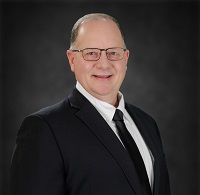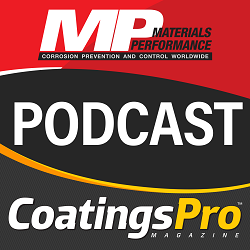Jeff Jirak, managing director of AkzoNobel’s global powder coatings business, recently joined the AMPP Interview Series of podcasts with insight regarding how new coating technologies are helping to mitigate corrosion in the built environment.
 Among numerous topics, the show explores the coating manufacturer’s recent development partnership with coatingAI, which aims to assist contractors and installers with application processes while reducing their carbon footprint. Known as Flightpath, the industry-fight technology optimizes equipment settings to reduce defects and overspray while improving material consumption and usage patterns.
Among numerous topics, the show explores the coating manufacturer’s recent development partnership with coatingAI, which aims to assist contractors and installers with application processes while reducing their carbon footprint. Known as Flightpath, the industry-fight technology optimizes equipment settings to reduce defects and overspray while improving material consumption and usage patterns.
Read on for a partial Q&A transcript, and listen to the full episode online at www.coatingspromag.com/podcasts or at the embedded link beneath this article.
Q: What are the common themes when it comes to corrosion concerns in the built environment, as well as the types of technologies and solutions that you all have to address those?
Jirak: Generally speaking, it’s about the location of each building. Whether it’s near a sea coast or inland, or in a hot or cold climate, those are the variables that determine what types of materials and performance levels are needed. We offer the full spectrum of performance levels, including some materials with warranties as high as 30 years.
We’ve done a lot of weather testing and UV [ultraviolet] testing in different environments, and we put our products through strenuous testing. So, within our product portfolio, there are varying degrees of selection that an architect and building designer can use.
There are lots of different ways to go about corrosion control. One of the things we find in coatings is that it’s partly about the design and chemistry. That’s referring to the polymers, the additives, and different tricks we may have in our laboratories.
But what’s just as important is how you apply it. For example, consider the surface preparation of a metal … for the environment that it’s going to be in. For example, on a sea coast, we have various certifications in the United States and Europe, and we have all of this testing data for those qualifications.
An architect can choose, based on our technical support, what might be the best cost-versus-technology offering to meet a certain specification, depending on what they’re trying to achieve with their design. That’s why we offer all that technical support, and why we have the full range of products to offer, depending on what their criteria is for the building.
In each one of these product offerings, we can offer the needed performance as far as durability and corrosion resistance, depending on where it’s located. But we also back that with warranties based on our testing data, which give assurance to the building owner, designer, or architect. Keep in mind, they’re all putting their name on these buildings. We’ve had very prominent buildings that have been selected to use our coatings because of their durability.
And a lot of it comes down to the [surface] preparation and the technical advice we provide while they’re coating … to make sure that all the surface prep and pretreatment is proper, and then the actual coating goes on in a very certified way.
That’s where this whole coatingAI thing has come up, where we’ve now partnered with an AI [artificial intelligence] company to help us develop a set of algorithms that will help clients and customers set up their processing lines for how to spray, how to cure, and how to do it in the most optimal way. You get very good first-pass yields, and you get good productivity through their lines.
Q: Can you explain a bit more about how that coatingAI system works, and what the savings are?
Jirak: We’ve worked with this firm in an exclusive way, to where we’ve loaded data and database information from our testing through various different lines. We have so much data from over the years. And then, as we’re working with customers, we’re also testing new lines and new configurations.
In each of these situations, there’s pretreatment and then there is the coating being applied, typically through robotics, robotic and guns, electrostatic guns, things like that. These guns can be at different levels, different nozzles, different spray patterns and frequencies. There are lots and lots of variables.
What the AI programming has done is it has helped us narrow it down to the optimization of those variables, depending on the size of the part, the configuration, and how the customer wants to process that part with film thickness, cure times, and oven temperature management.
 From a sustainability perspective, we want to make sure we’re using the least amount of energy needed to cure the polymer. But in many cases, you can adjust throughput, as well. You can get more productivity through a line, and the use of capital becomes much more of a benefit to the customer.
From a sustainability perspective, we want to make sure we’re using the least amount of energy needed to cure the polymer. But in many cases, you can adjust throughput, as well. You can get more productivity through a line, and the use of capital becomes much more of a benefit to the customer.
We’re just getting started with this, but we’re finding that customers are really in tune. Because not only does it help you tune your process, so that it can be very sustainable to the optimal use of energy … but it also can optimize a customer’s capital investment, their cost structure, and their yield loss.
One of the interesting things we’ve found is that one of the bigger benefits is that we can help customers [avoid] defects when they’re doing changeovers in parts. With a lot of our customers, they run different types of configurations all the time. What they can do is program that configuration into the algorithm, and it’ll give an initial setting of guns, heat temperatures, speeds, etc.
What we’ve found is you can get pretty close on that first pass, and customers are saying that [it] saves them from a lot of defect rejects. And when you’re coating some big parts, that can be very costly, just in terms of the yield loss alone.
So, this is becoming a really useful tool for us. It allows us to not only offer a broad spectrum of products but to then help our customers understand what they can do to optimize their lines.
Q: What type of feedback have you received? What does the future look like?
Jirak: The biggest thing is that because it’s AI, it’s machine learning. You’re learning from a database of data. So as the data builds and you look at different gun configurations, temperatures, and part sizes, there are all these different variables. Machine learning helps to optimize it, and there’s always more room to grow there.
We did some testing … where we picked our best technical service representatives that have been tuning lines for 30 years, in many cases. We put them up against the coatingAI program, and the coatingAI program beat our best rep several times in trials in a laboratory setting. That just gave us the confidence that, yes, this technology is real.
To optimize it, you still need knowledgeable people. It’s not a robot. It’s a different way of using our technology.
Our testing has given us a lot of confidence that this can work, but it is very line specific. It’s dependent on what the customer is using the line for and how many different things they’re running through it, as well as the production rate, film thickness, and maybe 25 or 30 other variables. But that’s what makes it valuable for AI, because the computer doesn’t care how much data you throw at it. Overall, it’s very beneficial.
For more information, contact: AkzoNobel, (629) 802-3999, www.akzonobel.com.
Jirak’s comments were made on the AMPP Interview Series. To hear the complete podcast episode, listen below.